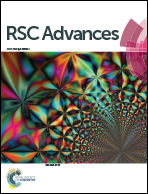Evaluation of Sm0.95Ba0.05Fe0.95Ru0.05O3 as a potential cathode material for solid oxide fuel cells
Abstract
The perovskite Sm0.95Ba0.05Fe0.95Ru0.05O3 (SBFR) is investigated to assess its possible use as a potential cathode material for solid oxide fuel cells. SBFR shows good thermal stability and has good chemical compatibility with the yttria-stabilized zirconia (YSZ) electrolyte below 1000 °C. In the oxygen partial pressure (pO2) range of 0.01–0.6 atm, the electrical conductivity of the SBFR sample follows a pO21/6 dependency, attributed to p-type electronic conductor behavior. Polarization resistance (Rp) increases with a decrease in pO2 (n = 0.53) and decreases with an increase in the amplitude of the applied direct current (DC) bias at 800 °C. The Rp values of the SBFR sample on the YSZ electrolyte in symmetrical cells are 0.28, 0.22, 0.15 Ω cm2 at 700, 750 and 800 °C, respectively, and the maximum power density of the YSZ electrolyte-supported single cell with the Ni-YSZ anode and SBFR cathode reaches 465 W cm−2 at 800 °C using pure H2 as a fuel and ambient air as an oxidant.


 Please wait while we load your content...
Please wait while we load your content...